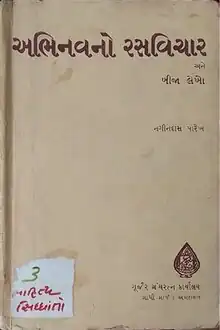Abhinavano Rasavichar
Abhinavano Rasavichar (Gujarati pronunciation: [əbʰinəvno rəsəvicar]; English: Rasa theory of Abhinavagupta) is a 1969 Gujarati language collection of critical essays by Indian writer Nagindas Parekh that deals with the theory of Indian poetics. The work won the Sahitya Akademi Award in 1970.
 cover page | |
| Author | Nagindas Parekh |
|---|---|
| Original title | અભિનવનો રસવિચાર |
| Country | India |
| Language | Gujarati |
| Subject | Indian poetics |
| Genre | critical essay |
Publication date | 1969 |
| Awards | Sahitya Akademi Award (1970) |
| OCLC | 26778342 |
Contents
In Abhinavano Rasavichar, the author has examined the theory of Indian poetics. The work has eight essays.[1]
The title essay explains Abhinavagupta's view on Rasa as expressed in his commentary on Bharata's Natya Shastra. The other articles discuss Vakrokti theory of Kuntaka, Ramaniyata theory of Jagannath. It discusses in details about Śṛṅgāraḥ (erotic), Hāsya (humour) and Shānta (sublime) sentiments, Auchitya (propriety) and Rasabhas (illusory experience of pleasure). The author has also discussed the poetic form of akhyana, showing how Akhyana was a figure of speech, and it was falsely interpreted as a form of poetry.[1][2]
Reception
For its profundity of erudition, soundness of judgement and its flowing prose, Abhinavano Rasavichar is considered an outstanding contribution to Gujarati literature.[1]
References
- Mehta, Chandrakant; Dave, Pinakin N. (2005) [1994]. "Abhinavano Rasavichar". In Abichandani, Param; Dutt, K. C. (eds.). Encyclopaedia of Indian Literature (Supplementary Entries and Index). Vol. VI. New Delhi: Sahitya Akademi. pp. 4654–4655. ISBN 9780836422832. OCLC 34346409.
- Kothari, Jayant (2001). "અભિનવનો રસવિચાર [Abhinavano Rasavicāra]". In Thaker, Dhirubhai (ed.). Gujarati Vishwakosh [Gujarati Encyclopedia] (in Gujarati). Vol. 1 (2nd ed.). Ahmedabad: Gujarat Vishwakosh Trust. pp. 348–349. OCLC 248967673.
External links
- Abhinavano Rasavichar in Gujarati Vishwakosh.
- Abhinavano Rasavichar at the Internet Archive (Hindi translation)